Bhushan B. Nanotribology and Nanomechanics: An Introduction
Подождите немного. Документ загружается.

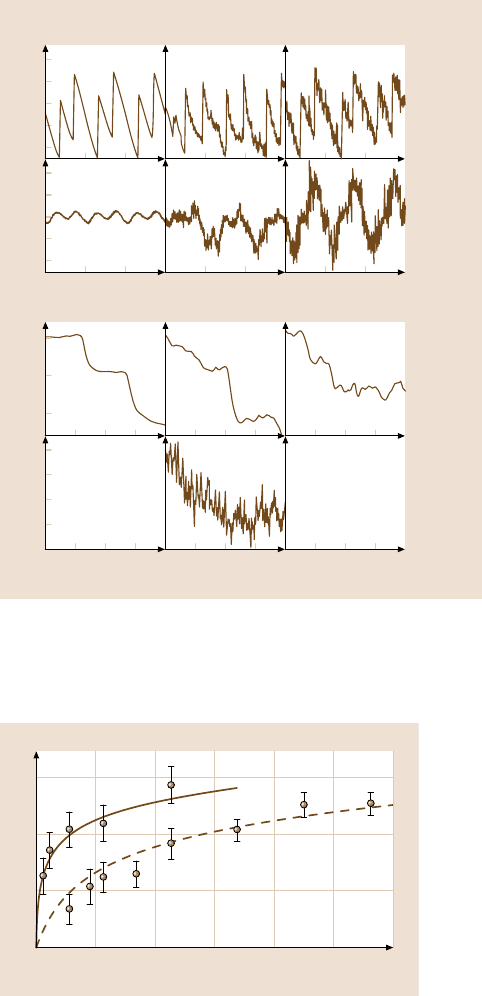
13 Computer Simulations of Nanometer-Scale Indentation and Friction 707
2
2
Shear stress ô/ô
0
5
å
1
/å
0
= 0.1
1
0
1
2
d)
34234234
å
1
/å
0
= 1.0
2
0
2
a)
T = 20K
e)
b)
f)
c)
T = 100K T = 300K
0
Displacement (D/a)
Heat flow Q/Q
0
1.0
å
1
/å
0
= 0.1
00
å
1
/å
0
= 1.0
0.5
g)
j)
h) i)
0.25 0.5 0.75 0.25 0.5 0.75 0.25 0.5 0.75
0
1
0
0.1
0.2
0.3
Fig. 13.50a–j. Data from molecular dynamics simulations of the sliding of the surfaces shown
in Fig. 13.32. (a)–(f) The shear stress and (g)–(j) the heat flow as a function of sliding for
normal and reduced interfacial strengths. The plots show how the calculated values change
with system temperature. After [174] with the permission of the APS (1993)
0
0
Velocity v/v
0
Friction <ô >/ô
0
0.5
1.0
1.5
0.01 0.02 0.03 0.04 0.05 0.06
T = 300K
T = 200K
Fig. 13.51. A plot of calcu-
lated values of the average
interfacial shear stress as
a function of the velocity of
sliding of the two surfaces
shown in Fig. 13.33. Af-
ter [174] with the permission
of the APS (1993)
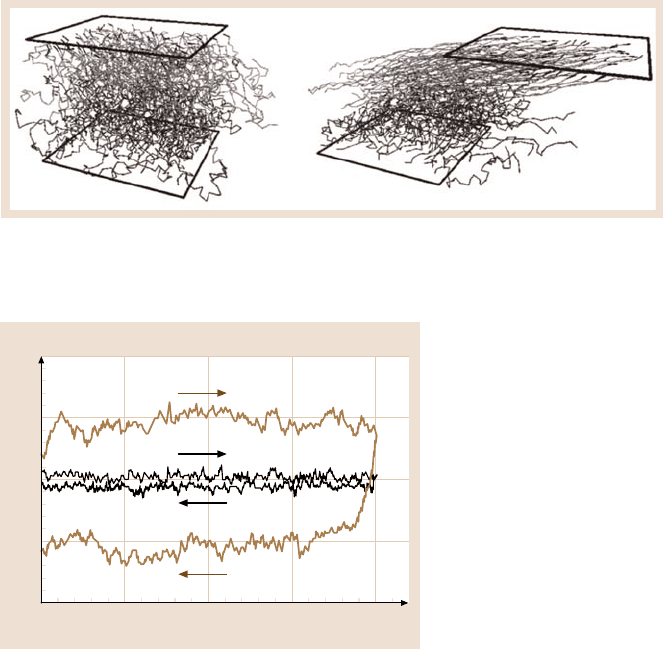
708 Susan B. Sinnott et al.
fected by the rate of sliding and is much larger at high sliding rates than small rates,
as indicated in Fig. 13.52. The simulations further show that the inclination angle
of the chains decreases much more slowly than the shear stress, and the shear stress
maximum is more pronounced if there is hysteresis in the chain orientations.
Typical friction loops for tips that are functionalized and sliding against surfaces
that are functionalized in the same manner as illustrated in Fig. 13.25 are shown in
Fig. 13.53. The friction force between the OH/OH pairs is significantly larger than
the friction force between the CH
3
/CH
3
pairs. This is due to the formation and
breaking of hydrogen bonds during the shearing for the OH/OH pairs. The mean
forces vs. load forces for the OH/OH and CH
3
/CH
3
pairs given in Fig. 13.54 are
reduced by the tip radius.
MD simulations by Manias et al. considered the shearing of entangled oligomer
chains that are attached to sliding surfaces, as illustrated in Fig. 13.55 [234]. They
find that slip takes place within the film and that this occurs through changes in the
chain conformations. Increased viscosity is predicted at the film–surface interface
Fig. 13.52. Snapshots of sliding walls with attached polymers in a solvent. Right-hand figure
illustrates the sliding process at low sliding rates while the left-hand figure illustrates the
sliding process at high sliding rates. After [41] with the permission of the CCLR (2002)
0
10
X displacement (Å)
Friction force (nN)
5101520
5
0
5
10
OH/OH
CH
3
/CH
3
Fig. 13.53. Typical friction
loops for the systems shown
in Fig. 13.25 for CH
3
/CH
3
and OH/OH pairs under
a contact load of 0.2nN.Af-
ter [160] with the permission
of the ACS (2002)
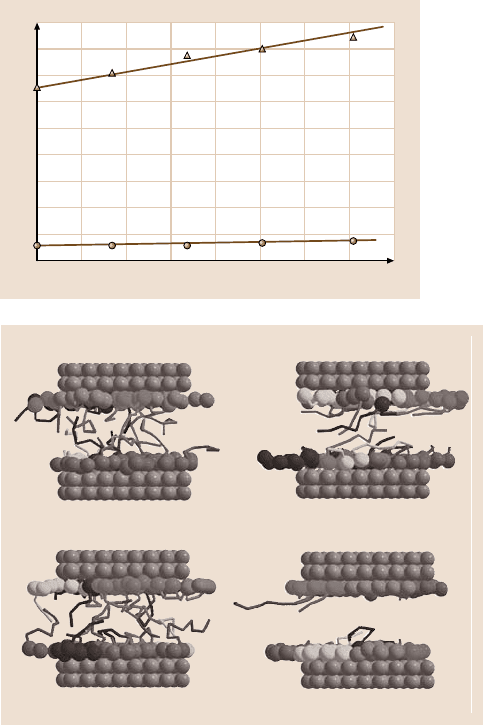
13 Computer Simulations of Nanometer-Scale Indentation and Friction 709
compared to the middle of the film, which results in a range of viscosities across the
film as one moves away from the points of sliding contact.
To summarize this section, experiments and MD simulations show similar
stick/slip transitions that occur for thin films of liquid between two sliding solid
surfaces. Frictional properties are found to depend to a significant degree on molec-
ular shape, whether the molecules are grafted on the surfaces or merely absorbed
on them, and the degree of tilting in the case of molecular chains. In the case of
long-chain molecules, temperature is found to affect the frictional force because the
0
0
Load force F
n
/R (nN/nm)
Friction force F
x
/R (nN/nm)
0.02 0.04 0.06 0.08 0.1 0.12 0.14 0.16
0.2
0.4
0.6
0.8
1
1.2
1.4
1.6
1.8
CH
3
/CH
3
(á = 0.045)
OH/OH (á = 2.4)
Fig. 13.54. Friction force
versus contact load from the
systems shown in Fig. 13.25
for CH
3
/CH
3
and OH/OH.
After [160] with the permis-
sion of the ACS (2002)
Equilibrium (no flow) Under shear flow
Wall affinity 1.0kT
Wall affinity 2.0kT
Fig. 13.55. Changes in the conformation of adsorbed hydrocarbon chains on weakly (top)
and strongly (bottom) physisorbing surfaces at equilibrium and under shear. After [234] with
the permission of the ACS (1996)
710 Susan B. Sinnott et al.
mechanical energy stored in long-chains can be converted into thermal energy by
friction.
Self-Assembled Structures
There have been numerous experimental studies of friction on SAMs on solid sur-
faceswith AFM and FFM.The experimentalresults revealrelationshipsamongelas-
tic compliance, topography and friction on thin LB films [235]. For example, they
have detected differences in the adhesive interactions between the microscope tips
and CH
3
and CF
3
end groups[106]. Fluorocarbon domains generally exhibit higher
friction than the hydrocarbon films, which the authors attribute to the lower elastic-
ity modulusof the fluorocarbonfilms thatresults in a largercontact area betweenthe
tip and the sample [235–237]. Perry and coworkers examined the friction of alka-
nethiols terminated with −CF
3
and −CH
3
[238]. The lattice constants for both films
are similar and the films are well-ordered. The friction of the SAMs with chains that
are terminated with fluorine end groups is larger than the friction of the SAMs with
chains that are terminated with hydrogen end groups. However, the pull-off force
is similar in both systems, which implies that these end groups have similar contact
areas. The authors speculate that the larger −CF
3
groups interact more stronglywith
adjacent chains than the −CH
3
-terminated chains. Therefore, the fluorinated chains
have more modes of energy dissipation within the plane of the monolayer and, thus,
have larger friction.
Molecular disorder of the alkyl chains at the surface can also affect the fric-
tional properties of self-assembled films if the layers are not packed too closely
together [240]. Indentation can induce disorder in the chains that then compress as
the tip continues to press against them. If the tip presses hard enough, the film hard-
ens as a result of the repulsive forces between the chains. However, if the chains are
tilted, they bend or deform when the tip pushes on them in a mostly elastic fashion
that produces long lubrication lifetimes. At low contact loads of about 10
−8
N, wear
usually occurs at defect sites, such as steps. Wear can also occur if there are strong
adhesive forces between the film and the surface [241].
The friction of model SAMs composed of alkane chains was examined us-
ing MD simulations with bond-order and LJ potentials by Mikulski and Harri-
son [239, 242]. These simulations show that periodicities observed in a number of
system quantities are the result of the synchronized motion of the chains when they
are in sliding contact with the diamond counterface. The tight packing of the mo-
nolayer and commensurability of the counterface are both needed to achieve syn-
chronized motion when sliding in the direction of chain tilt. The tightly packed
monolayer is composed of alkane chains attached to diamond (111) in the (2×2) ar-
rangementand the loosely packedsystem has approximately30% fewer chains. The
average friction at lowloads is similar in boththe tightly and looselypacked systems
at low loads. Increasing the load, however, causes the tightly packed monolayer to
have significantly lower friction than the loosely packed monolayer (Fig. 13.56).
While the movement of chains is somewhat restricted in both systems, the tightly
packed monolayer under high loads is more constrained with respect to the move-
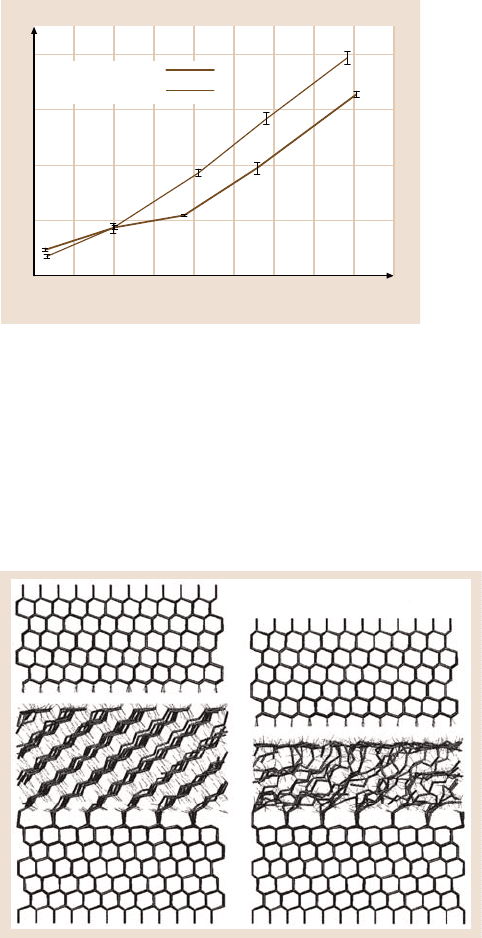
13 Computer Simulations of Nanometer-Scale Indentation and Friction 711
100
0
Load (nN)
Friction (nN)
10
20
30
40
200 300 400 500 600 700 800 900 1000
Tight packing
Loose packing
Fig. 13.56. Friction as a func-
tion of load when a hydrogen-
terminated counterface is
in sliding contact with C
18
alkane monolayers. Af-
ter [239] with the permission
of the ACS (2001)
ment of individual chains than the loosely packed monolayer, as illustrated in
Fig. 13.57. Therefore, sliding initiates larger bond-length fluctuations in the loosely
packed system, which ultimately lead to more energy dissipation via vibration and,
thus, higher friction. Thus, the efficient packing of the chains is responsible for the
lower friction observed for tightly packed monolayers under high loads.
Several AFM experiments have examined the friction of SAMs composed of
chains of mixed lengths [243]. For example, the friction of SAMs composed of
Fig. 13.57. Snapshots of tightly packed C
18
alkane monolayers on the left, and loosely packed
monolayers on the right under a load of about 500 nN. The chains in both systems are ar-
ranged in a (2×2) arrangement on diamond (111). The loosely packed system has 30% of
the chains randomly removed. The sliding direction is from left to right. After [239] with the
permission of the ACS (2001)
712 Susan B. Sinnott et al.
spiroalkanedithiols was examined by Perry and coworkers [244]. The effects of
crystalline order at the sliding interface were examined by systematically shortening
some of the chains. The resulting increase in disorder at the sliding interface causes
an increase in friction.
The link between friction and disorder in monolayers composed of n-alkane
chains was recently examined using MD simulations by Harrison and cowork-
ers [245]. The tribological behavior of monolayers of 14 carbon atom-containing
alkane chains, or pure monolayers, was compared to monolayers that randomly
combine equal amounts of 12 and 16 carbon-atom chains, or mixed monolayers.
Pure monolayers consistently show lower friction than mixed monolayers when
sliding under repulsive (positive) loads in the direction of chain tilt. These MD
simulations reproduce trends observed in AFM experiments of mixed-length alka-
nethiols [243] and spiroalkanedithiols on Au [246].
Because the force on individual atoms is known as a function of time in MD
simulations, it is possible to calculate the contact forces between individual mono-
layer chain groups and the tip, where contact force is defined as the force between
the tip and a −CH
3
or a −CH
2
- group in the alkane chains. The distribution of
contact forces between individual monolayer chain groups and the tip are shown
in Fig. 13.58. It is clear from these contact force data that the magnitude, or scale
of the forces, is similar in both the pure and the mixed monolayers. In addition, it
is also apparent that the pure and mixed monolayers resist tip motion in the same
way. That is, the shape of the histograms in the positive force intervals is similar.
In contrast, the contact forces “pushing” the tip along differ in the two monolayers.
The pure monolayers exhibit a high level of symmetry between resisting and push-
ing forces. Because the net friction is the sum of the resisting and pushing forces,
the symmetry in these distributions of the pure monolayers results in a lower net
friction than the mixed monolayers. Thus, the ordered, densely packed nature of
the pure monolayers allows the energy stored when the monolayer is resisting tip
motion (positive forces) to be regained efficiently when the monolayer “pushes” on
the tip (negative forces). The distribution of negative contact forces in the mixed
monolayers is different from the distribution of the positive forces. For this reason,
mechanical energyis not efficiently channeled back into the mixed monolayeras the
tip passes over the chains and, as a result, the friction is higher. The range of motion
of the chains is monitored by computing the deviation in a chain group’s position
compared to its starting position, as illustrated in Fig. 13.59. It is clear from analyz-
ing these data that the increased range of motion is linked to large contact forces.
The increased range of motion of the protruding tails in the mixed system prevents
the efficient recovery of energy during sliding (negative contact force distribution)
and allows for the dissipation of energy.
The pure monolayers exhibit marked friction anisotropy. The contact force dis-
tribution changes dramatically as a resultof the change in sliding direction, resulting
in an increase in friction (Fig. 13.58). Sliding in the direction perpendicular to chain
tilt can cause both types of monolayers to transition to a state where the chains are

13 Computer Simulations of Nanometer-Scale Indentation and Friction 713
0.8
0.8
Force interval (nN)
Net force (nN)
0.4 0 0.4 0.8
Pre-transition
Post-transition
0.4
0
0.4
0.8
0.8
Pure SAM
Mixed-SAM
0.4
0
0.4
0.8
Pure SAM
Fig. 13.58. Thedistribution of contact forces along the sliding direction (friction force). Inthe
upper panel, the forces for the mixed and pure system sliding in the direction of chain tilt are
shown. The forces for the pure system sliding in the transverse direction to the chain tilt are
shown in the lower panel. Positive force intervals correspond to chain groups that resist tip
motion while negative intervals correspond to chain groups that “push” the tip in the sliding
direction. Forces from four runs with independent starting configurations are binned for all
sets of data
0
4
Sliding distance (Å)
Deviation (Å)
0
4
1020304050607080
Mixed SAM
4
0
4
Pure SAM
Fig. 13.59. Trajectories of individual chain groups that generate the largest contact forces
when sliding in the direction of chain tilt for both the pure and mixed monolayer systems.
The deviation is defined as the change in position along the sliding direction relative to the
chain group’s starting position. (The positions are averaged over 2000 simulation steps)
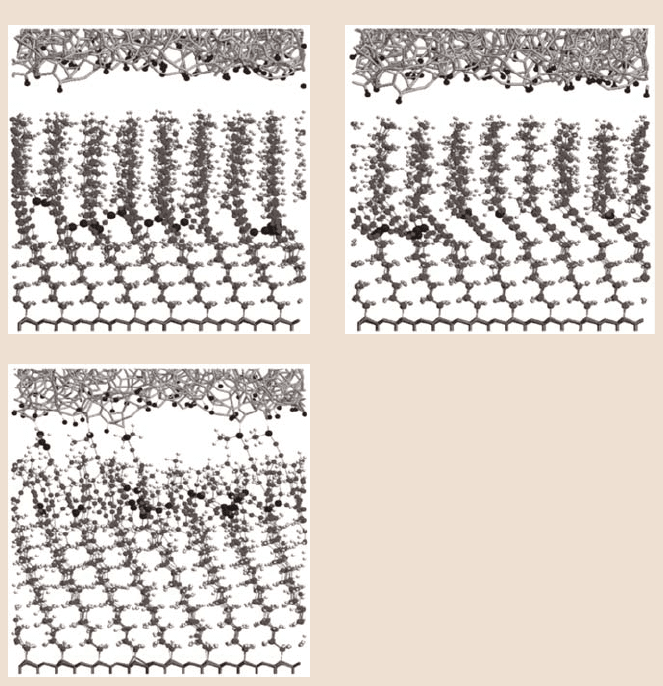
714 Susan B. Sinnott et al.
primarily tilted along the sliding direction. This transition is accompanied by a large
change in the distribution of contact forces and a reduction in friction.
Recently, the response of monolayers composed of alkyne chains, which con-
tain diacetylene moieties, to compression and shear [247] was examined using MD
simulations. These are the only simulations to date that show that compression and
shear canresult in cross-linking,or polymerization,between chains. Theverticalpo-
sitioningof the diacetylenemoieties within the alkynechains (spacer length)and the
sliding direction both have an influence on the pattern of cross-linking and friction.
Compression and shear cause irregular polymerization patterns to be formed among
a) b)
c)
Fig. 13.60. (a) Perpendicular-, (b) tilted-, and (c) end-chain monolayer systems after com-
pression to 200 nN and pull-back of the hydrogen-terminated tip. Large, dark spheres in the
hydrocarbon monolayers represent cross-linked atoms with sp
2
hybridization. Dark, small
spheres represent hydrogen atoms that are initially on the hydrogen-terminated amorphous
carbon tip. After [247] with the permission of the ACS (2004)
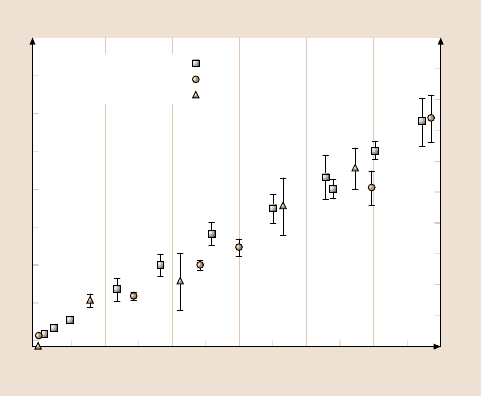
13 Computer Simulations of Nanometer-Scale Indentation and Friction 715
the carbon backbones, as illustrated in Fig. 13.60. When diacetylene moieties are
located at the ends of the chains closest to the tip, chemical reactions between the
chains of the monolayer and the amorphous carbon tip occur causing the friction to
increase 100 times, as indicated in Fig. 13.61. The friction between the amorphous
carbon tip and all of the diacetylene-containing chains is larger than the friction be-
tween a hydrogen-terminated diamond counterface and tightly packed monolayers
composed of n-alkane chains [239]. This is attributed to the disorder at the interface
caused by the irregular counterface.
Zhang et al. [248] used MD simulations to study the effect of confined wa-
ter between alkyl monolayers terminated with −CH
3
(hydrophobic) and −OH (hy-
drophilic) groups on Si(111), as illustrated in Fig. 13.62. For the hydrophobic
molecules, the friction coefficient is almost constant independent of the number of
water molecules. For the hydrophilic molecules, the friction coefficient decreases
rapidly with an increase in the number of water molecules, as shown in Fig. 13.63.
These results are in good agreement with surface force microscopy (SFM) experi-
mental results. Zhang et al. [249] also studied the friction of alkanethiol SAMs on
gold using hybrid molecular simulations at the same time scales as are used in AFM
and FFM experiments. Various quantities were varied in the simulations, includ-
ing chain length, terminal group, scan direction and scan velocity. The simulations
showed that the frictional force decreases as the chain length increases and is small-
est when scanned along the tilt direction. They also predicted a maximum friction
coefficient for hydrophobic −CH
3
-terminated SAMs and low friction coefficients
for hydrophilic −OH-terminated SAMs as the scan velocity increases. The simulat-
0
0
Average load (nN)
Average friction (nN)
0
40
180
50
100
150
200
250
10
20
30
30 60 90 120 150
Average friction (nN) end-chains only
Perperdicular-chains
Tilied-chains
End-chains
Fig. 13.61. Average friction on the tip as a function of load for the monolayer systems shown
in Fig. 13.60. The scale for the average friction in the end-chain system is shown on the
right-hand side of the figure. After [247] with the permission of the ACS (2004)
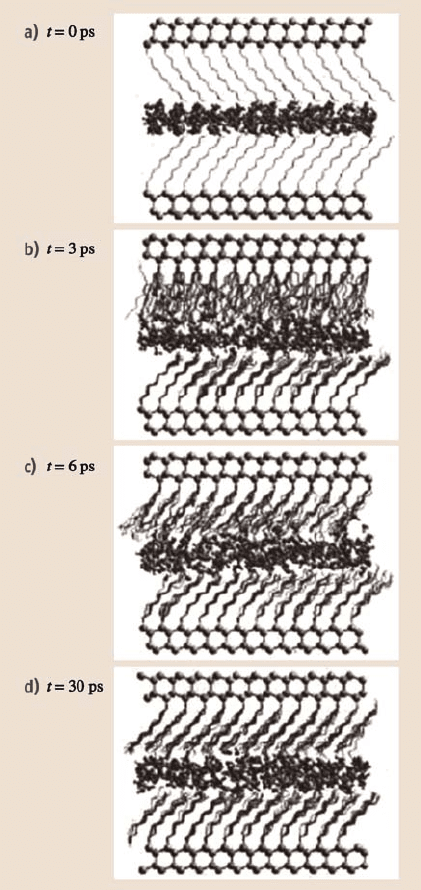
716 Susan B. Sinnott et al.
Fig. 13.62a–d. Snapshots of
hydrophilic monolayers and
confined water molecules
from MD simulations at
300 K. The tilt direction of
monolayers on the top plate
changed after t = 10.0ps.Af-
ter [248] with the permission
of the AIP (2005)
ions further predicted a saturated constant value at high scan rates for both surfaces.
These results are summarized in Figs. 13.64 and 13.65.
The work of Chandross et al. [250,251] illustrates the effects of chain length
on friction and stick-slip behavior between two ordered SAMs consisting of alkyl-
silane chains over a range of shear rates at various separation distances or pressure,
as illustrated in Fig. 13.66. The adhesion forces between the two SAMs at the same
